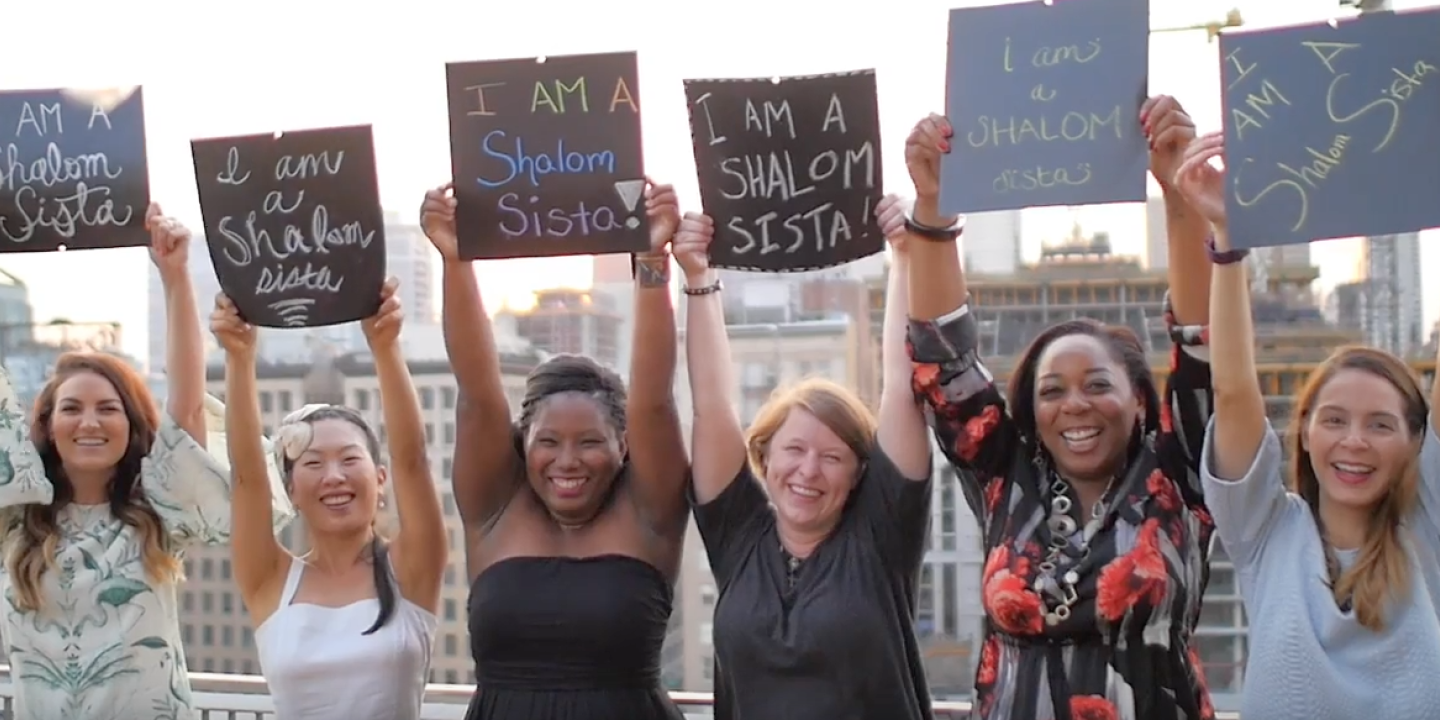Being a Shalom Sista in a brokenhearted world
What does it look like to embody the peace of the city of God?

It is a truth universally acknowledged that a millennial woman in possession of a life verse or a particularly moving quote from, say, Rumi or Oprah will be in want of a way to memorialize it. Top considerations include (1) a blog, (2) a piece of artwork made from reclaimed wood or restored metal, and (3) a tattoo.
Near the end of a Lenten experiment with 40 days of peace, I had two out of three: a blog and a trendy piece of handcrafted wall art emblazoned with my family’s favorite Bible verse, “Seek the peace and prosperity of the city to which I have carried you into exile. Pray to the Lord for it, because if it prospers, you too will prosper” (Jer. 29:7). But I wanted more.
Read our latest issue or browse back issues.
“Babes!” I called to my husband T. C., “I’m gonna start a new blog.”
“That’s what? Blog number three?” he called back. “First was the mommy blog, and then the urban ministry blog. What is this one going to be about?”
I rolled my eyes at his sarcasm. “A shalom blog! A kingdom blog. One blog to rule them all!” I announced. Because yes, gentle reader, as a millennial, I must tell all the Internet that big things were happening in my neck of the woods.
T. C. was quiet for a beat, then responded from the other room, “That might be a hard sell, babers.” (He calls me babers. I call him babes. I have no idea when or why this started.) “Shalom and the kingdom of God are pretty big concepts, plus you still really do love the city. How are you going to tie those together?”
“Hmm,” I started, as I wrote blog title ideas in my journal. “Well . . . how about Shalom City? Like Sin City, but a play on words.”
T. C. got up from the comfort of his chair to stand in the doorway between our kitchen and living room. He gave me the flattest, most unimpressed deadpan look ever known to husbands. “Shalom City?” he repeated. It sounded even worse coming from him.
“OK, it’s pretty bad. I know! Give me a minute.” He checked his phone for the time, crossed his arms, leaned against the door frame, and waited. Deadpan still in effect.
I scribbled “Shalom” and a combination of ideas for the blog with the same enthusiasm I had when I first met T. C. and dreamed up different configurations of my first name with our lasts. Feeling his interest slip away, I flipped to a page of notes from a book that referenced Augustine’s The City of God. With my husband leaning against the door, the clock counting down, and my mind whirring, I had one thought: If the city of God had a name that could describe its personality, what would it be?
Shalom. Shalom expresses the complexity of the goodness of God with the practical application modeled by Jesus. That ache you feel, the sense that the world is not right? That’s the shalom in the city of God calling us back home. It’s Jeremiah 29:7.
Not everyone is called to a physical city here on earth, but everyone can find wholeness in the city of God. Not everyone knows what it’s like to physically live an exiled life—driven away from the land you and your ancestors love. But because sin entered the garden of Eden, we are all exiles from the city of God. In this world, there’s a universal desire for rest. In every sigh, every tear, every disgusted exclamation and shake of the head over a world gone wrong, we are embodying the heartbreak of our exile from the city of God. We all want to make our way back home. What, then, does it look like to embody the shalom of the city we long for?
“Shalom in the City!” I announced to the waiting man.
He pursed his lips and stood up a bit straighter. He liked it, I could tell. But knowing my husband, he was also going to make me defend this decision. “Why?”
I told him about Augustine’s city of God, and loving urban life, and embodying shalom and yearning for the garden of Eden. “We live out the kingdom of God on earth because Jesus told us to!” I added that last part in for good measure. Everyone knows Sunday school survival rule no. 1: add Jesus to your answer and you’ll always get a cookie.
So T. C. bought the domain name shalominthecity.com and quietly began building me a website. And me? On Good Friday of my 40 days of peace, I recommitted myself to our humble King and got a tattoo of a dove on my right wrist. Three for three.
In A Hidden Wholeness, Parker Palmer encourages us to look closely at our brokenheartedness and let it lead us to wholehearted living. “Wholeness does not mean perfection,” Palmer writes, “it means embracing brokenness as an integral part of life. Knowing this gives me hope that human wholeness—mine, yours, ours—need not be a utopian dream, if we can use devastation as a seedbed for new life.”
In our culture, we’ve been conditioned to run away from brokenheartedness. But in the kingdom of God, brokenness is beautiful, and wholeness comes when we lean into our breaking. When the woman with the alabaster jar wept, broken and vulnerable before Jesus, he called that act beautiful. In fact, it is the only time in the Bible that Jesus describes an act as beautiful.
And take Jesus himself, who was crowned king on the cross and rose on the third day. He lived out another ethic of the kingdom of God: that we are broken by the same things that break God’s heart. Then and only then we are made whole.
As I studied peace and blogged about it, I started calling myself a Shalom Sista. Shalom Sistas are not well-behaved, tame women, because peace is not a thing that can be tamed. Calling myself a Shalom Sista meant I focused on fully living into God’s dream of wholeness for me in a brokenhearted world. Shalom Sistas recognize that brokenheartedness and wholehearted living are not opposites. No, we hold these things in tension. We’re beautiful and we’re broken.
There’s a curious line in the bridge of a song we sing at church that asks God to break our hearts for the things that break God’s heart. Shalom Sistas attempt to live out that prayer. We allow our hearts to break for the things that break God’s so that we can be co-laborers for flourishing. In doing so, we live out our humanness at its fullest—heartbreak, pain, and all.
Twelve core beliefs and action steps have shaped my practice as a Shalom Sista. We are invited to see God through Jesus. We are God’s beloved. In God’s kingdom, we are enough. We will see the beauty in our bodies and those of others. We will not only work, we will rest. In the face of injustice, we will choose subversive joy. We will tell better stories about those whose choices hurt us. We will serve before we speak. We will build bridges, not walls. In a world of broken systems, we will choose ordinary acts of peace. Against injustice, we will show up, say something, and be still. We will be nonviolent peacemakers, not peacekeepers.
Honestly, I’m not firing on all 12 cylinders every day. There are days I do well with telling better stories about others but struggle to rest. Other days I’m all about my belovedness, but I still look in the mirror and think, “If only I could be a few pounds lighter, I’d really be beautiful.” I identify with what Shonda Rhimes confessed in a graduation address at Dartmouth. When people ask her how she does it all, she said, “The answer is this: I don’t. Whenever you see me somewhere succeeding in one area of my life, that almost certainly means I am failing in another area of my life.”
The same is true for me as a shalom practitioner. It’s for this very reason that I started using the language of practice when it comes to peacemaking. Every day when I wake up, I can pray, “God, how can I practice shalom?” Living into the shalom of God is a learning process. “Shalom is something we seek every day,” my friend Sarah said offhandedly one time. “It’s a practice of peace, really, because we rarely get it right the first time. But Jesus helps us along, doesn’t he?”
A version of this article appears in the November 8 print edition under the title “How I became a Shalom Sista.” It was excerpted from Osheta Moore's book Shalom Sistas: Living Wholeheartedly in a Brokenhearted World, just published by Herald Press. All rights reserved. Used with permission.





